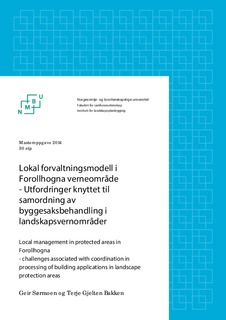Lokal forvaltningsmodell i Forollhogna verneområde
Master thesis
Permanent lenke
http://hdl.handle.net/11250/281100Utgivelsesdato
2015-04-09Metadata
Vis full innførselSamlinger
- Master's theses (ILP) [763]
Sammendrag
Denne oppgavens tema omhandler lokal forvaltning av verneområder. Det man kan
betegne som etableringsfasen av verneområder i Norge er mer eller mindre
gjennomført, og fremover er fokus hvordan verneområdene forvaltes.
I oppgaven undersøkes hvilke utfordringer den lokale forvaltningsmodellen står overfor
når det gjelder samordning av byggesaksbehandling i landskapsvernområder i
tilknytning til Forollhogna nasjonalpark. For å finne svar på dette har vi tatt
utgangspunkt i forvaltningen av landskapsvernområdene Vangrøftdalen‐Kjurrudalen
(Os kommune) og Londalen‐Ørvilldalen (Tolga kommune) i Hedmark fylke, og gjennom
dette undersøkt hvordan samordning mellom nasjonalparkstyre og kommune fungerer,
i tillegg til hvordan samordning med øvrige ansvarlige organer går til. Oppgaven tar også
for seg hvordan forskjellige planer for området legger føringer og grunnlag for en
helhetlig byggesaksbehandling.
Oppgavens empiri består av semistrukturerte, kvalitative intervjuer med representanter
fra verneforvaltningen i Forollhogna, deriblant deler av nasjonalparkstyret
nasjonalparkforvalter, samt representanter fra administrasjonen i kommunene Tolga og
Os og Fylkesmannen i Hedmark. I tillegg er det foretatt dokumentanalyse av sak‐, planog
styringsdokumenter i tilknytning til byggesaksbehandling. For å belyse oppgavens
problemstilling er det benyttet to eksempler på byggesaker fra de utvalgte
landskapsvernområdene.
Oppgavens teoretiske innfallsvinkel benytter ulike teoretiske tilnærminger til hvordan
samordning fungerer, og hvordan dette kan oppnås gjennom nettverk og hierarki. I
analysen av empirien drøftes samordningen mellom nasjonalparkstyret og kommune
for å definere hvilke former og nivå av samhandling som foreligger.
Resultatene fra studien peker på flere utfordringer knyttet til samordning, og det virker
å være et sammensatt bilde for hvordan nasjonalparkstyret og kommunene oppnår
helhetlig byggesaksbehandling i landskapsvernområdene. Gjennom intervjuene beskrev informantene fra både den kommunale forvaltningen og verneforvaltningen sine
oppfatninger av hva som oppleves som utfordrende. Mange av byggesakene i
landskapsvernområdene er kompliserte, ofte med hensyn til vurdering av
kulturhistorisk verdi, og avklaringer rundt dette krever fagkunnskap.
Nasjonalparkstyret er i stor grad avhengig av kompetanse som finnes i kommunen og
fylkeskommunen. Nettverket mellom det administrative kontaktutvalget og
nasjonalparkforvalteren er derfor en viktig brikke for at nasjonalparkstyret effektivt
skal kunne utøve sin rolle. Nasjonalparkforvalteren spiller en viktig rolle som brobygger
i et til dels sårbart nettverkssystem. Det har vært ulike oppfatninger blant sentral
vernemyndighet og den lokale vernemyndigheten angående bygninger i
landskapsvernområders formelle vernestatus, og sektorinteresser for bygningsvern kan
legge sterke føringer for hendelsesforløpet i byggesaker. De ulike planene i området
legger i mindre grad grunnlag for helhetlig byggesaksbehandling.
Funnene i oppgaven tyder også på at de organisatoriske betingelsene i den lokale
forvaltningsmodellen stiller til dels store krav til god samordning. Det må tas med i
vurderingen at forvaltningsmodellen er forholdsvis ny, og innarbeidelse av rutiner og
erfaringer er noe som skjer over tid.
This thesis deals with local management of protected areas. The phase of establishing
protected areas in Norway is more or less completed, and up front is how to deal with
the protected areas are to be managed.
This thesis examines the challenges related to the local management model concerning coordination of building permits in landscape areas adjacent to the Forollhogna National Park. To answer this we have focused on the management of protected landscape areas Vangrøftdalen‐Kjurrudalen (Os municipality) and Londal‐Ørvilldalen (Tolga municipality) in Hedmark County, and through this investigated how the coordination between the national park board and the municipalities works, in addition to how the coordination with other responsible agencies goes. The thesis also examines how different plans for the protected area provide guidelines and a basis for holistic building permits.
The empiricism in this thesis consists of semi‐structured, qualitative interviews with
representatives from the conservation management in Forollhogna, including members
of the National park board, the National park manager and representatives from the
administration in the municipalities Tolga and Os and the County governor of Hedmark.
In addition, it has been conducted a document analysis of building permit protocols,
management plans, planning‐ and policy documents related to building permits. To
illustrate the main topic of the thesis, it has been used two examples of building
aplications from within the selected Landscape protecion areas.
The thesis utilizes various theoretical approaches to how coordination works, and how
this can be achieved through network and hierarchy. In the analysis of the empirical
data, the coordination between National Board and council are being discussed, to
define what forms and level of interaction that exist.
The study results indicate several challenges related to coordination, and it seems to be
a complex picture of how the National Park Board and municipalities achieve a holistic
management of building permits in protected landscape areas. Through the interviews ,
the informants from both the municipal administration and conservation management
described their perceptions of what is perceived as challenging. Many of the building
applications in landscape conservation areas are complex, often with regard to
assessment of historical value and, clarifications of such matters requires expert
knowledge. The National Park Board is largely dependent on the expertise that exists in
the municipality and in the county. The network between the administrative contact
committee and the National Park Manager is therefore an important part for the
National Park Board to effectively exercise their role. The National Park Manager plays
an important role as a bridge in a somewhat vulnerable network system. There have
been different views among both the central protection authority and the local
conservation authority regarding the formal conservation status of buildings in the
protected Landscape area's, and sectoral interests for heritage conservation can add
strong guidelines for how in building applications goes. The various plans in the area
adds poor guidelines for a holistic management of building applications.
The thesis also suggests that the organizational conditions of the local management
model sets some major requirements for good coordination. It must be taken into
consideration that the management model is relatively new, and the incorporation of
practices and experiences is something that happens over time.
